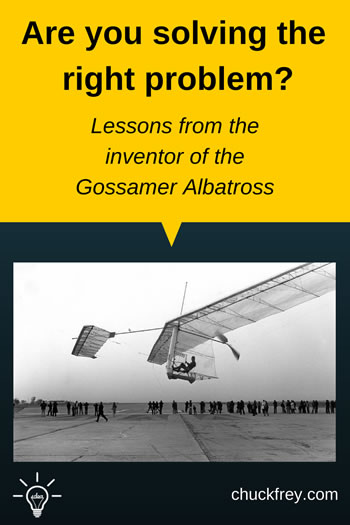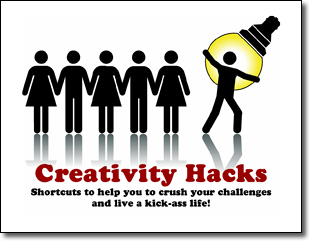Lessons from the inventor of the Gossamer Albatross
 Business people, when faced with a challenge, often decide what the problem is, and immediately throw their full weight into solving it. There’s only one problem with that approach: Often, they’re brainstorming solutions for the wrong problem.
Business people, when faced with a challenge, often decide what the problem is, and immediately throw their full weight into solving it. There’s only one problem with that approach: Often, they’re brainstorming solutions for the wrong problem.
This dilemma was brought to life for me in an article from UX Magazine in which inventor Paul MacCready developed a unique approach to the technical challenge of human-powered flight in 1959. A British magnate by the name of Henry Kremer offered the staggering sum of £50,000 to anyone who could design an aircraft capable of flying under the pilot’s own power. It was the X-Prize of its day – a seemingly impossible challenge with a big prize for anyone who was able to solve it.
Many people tried. The usual scenario was that they developed what they hoped was the winning design, spent a year or more building the aircraft and then watched their dreams go up in smoke when their fragile crafts crash landed. Back to the drawing board for another year or so of additional development and another attempt at the prize.
Reframing the challenge
MacCready realized that the REAL problem wasn’t building a human-powered aircraft. The problem was the nature of the problem itself:
“Paul realized that what needed to be solved was not, in fact, human powered flight. That was a red herring. The problem was the process itself, and along with it the blind pursuit of a goal without a deeper understanding how to tackle deeply difficult challenges. He came up with a new problem that he set out to solve: how can you build a plane that could be rebuilt in hours not months? And he did. He built a plane with Mylar, aluminum tubing, and wire.
The first airplane didn’t work. It was too flimsy. But, because the problem he set out to solve was creating a plane he could fix in hours, he was able to quickly iterate. Sometimes he would fly three or four different planes in a single day. The rebuild, retest, relearn cycle went from months and years to hours and days.”
The rest is history. MacCready’s Gossamer Condor flew 2,172 meters to win the prize. And a year later, his famous Gossamer Albatross flew across the English Channel, powered only by the muscles of its pilot.
Creative problem solving lessons learned
The lessons are clear: First, invest extra time – more time than you intuitively think is right – in problem definition. Be sure you’re solving the right problem before you begin brainstorming and implementing solutions. The solution to the wrong problem is useless.
The second lesson is to try to create inexpensive prototypes. When you don’t know what the right solution is, you have to try things. Use what you learn from experiments and feedback from potential customers to quickly iterate the design of your new product or service.
 Creativity Hacks will inspire you to explore in new places, to make new connections, to dig deeper and discover new insights. It will help you to seek out new knowledge and sources of inspiration - so you can profit from the opportunities all around you. When you're done reading Creativity Hacks, you'll be:
Creativity Hacks will inspire you to explore in new places, to make new connections, to dig deeper and discover new insights. It will help you to seek out new knowledge and sources of inspiration - so you can profit from the opportunities all around you. When you're done reading Creativity Hacks, you'll be:
- Empowered to solve problems and tackle challenges head-on.
- Able to see ideas and opportunities everywhere.
- Able to differentiate yourself and advance your career faster.
Above all, you'll learn that creativity is a skill YOU can cultivate!
